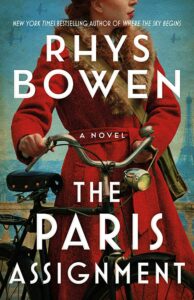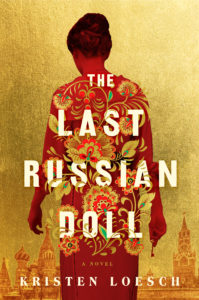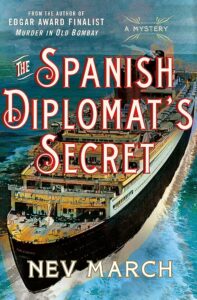There were some great and varied historical mysteries published this year. Some old favorites (Alexander, Benn, Massey, Montclair, Willig and Winspear), some great early series installments (Flower, Nagendra), and some sparkling debuts (Connally, Kelly, Rao). The fun was going all through time and all over the world – from Cecil B. DeMille filming The Ten Commandments on location in Egypt, to India, Scotland, England, France, Cuba and the east coast of the United States. That’s one reason I love historicals – the travel. The other reason is that they are the purest example of deductive reasoning around since they occur before computers and cell phones. The detectives have to use good old shoe leather and old fashioned thinking to solve the crimes – the best of them are truly transporting.
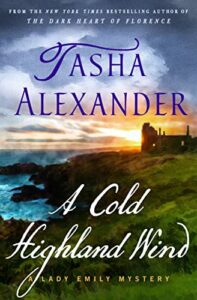 A Cold Highland Wind, Tasha Alexander. One of my favorites in this long series finds Lady Emily and family taking a vacation at their friend Jeremy’s Scottish castle. Emily’s boys are preoccupied with kelpies and faeries and out hunting for kelpies one morning stumble across the gamekeeper’s body. Of course Emily and Colin spring into action, interviewing everyone in the tiny Scottish town. There’s also a story thread set in the past following the story of Moorish maid Tansy and her mistress, Rossalyn, who have been expelled from their home by Rossalyn’s brother in law upon the death of her husband. In 1676, the women are suspected of being witches; that’s not the case in Emily’s 1905 universe but they are surrounded by folk tales and superstition, not to mention a stray copy of a Shakespeare folio tying the threads together. Alexander is such a smooth storyteller and she’s created beloved characters. I always look forward to a Lady Emily story and I am never disappointed.
A Cold Highland Wind, Tasha Alexander. One of my favorites in this long series finds Lady Emily and family taking a vacation at their friend Jeremy’s Scottish castle. Emily’s boys are preoccupied with kelpies and faeries and out hunting for kelpies one morning stumble across the gamekeeper’s body. Of course Emily and Colin spring into action, interviewing everyone in the tiny Scottish town. There’s also a story thread set in the past following the story of Moorish maid Tansy and her mistress, Rossalyn, who have been expelled from their home by Rossalyn’s brother in law upon the death of her husband. In 1676, the women are suspected of being witches; that’s not the case in Emily’s 1905 universe but they are surrounded by folk tales and superstition, not to mention a stray copy of a Shakespeare folio tying the threads together. Alexander is such a smooth storyteller and she’s created beloved characters. I always look forward to a Lady Emily story and I am never disappointed.
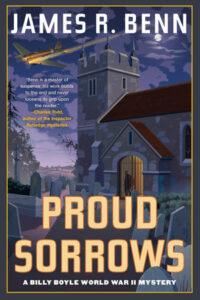 Proud Sorrows, James R. Benn. James R. Benn is never bad but I really loved this installment, which is his take on the village mystery, as Billy, Kaz, Angelika (Kaz’s sister, freed from Ravensbruck) and Diana get some much needed rest at Diana’s family estate. It’s located in King’s Lynn, when Billy and Diana, out for a ride, discover the wreckage of a Nazi plane with the body of a dead Englishman inside it. Before they know it they are back on the job, with a trail that takes them through the tiny village where Diana has grown up. Oh, and there’s also a POW camp for Nazi officers in town. There’s always a great set piece in these books, and in this one it’s a scene in the mansion where the Nazis are housed – very Sherlock Holmes (who is referenced). As always Benn’s intelligence as a writer shines through, and I don’t just mean his historical expertise. He’s also excellent and intelligent with plot, pacing, suspense and character. This was a great read. Read my interview with the fascinating James Benn here.
Proud Sorrows, James R. Benn. James R. Benn is never bad but I really loved this installment, which is his take on the village mystery, as Billy, Kaz, Angelika (Kaz’s sister, freed from Ravensbruck) and Diana get some much needed rest at Diana’s family estate. It’s located in King’s Lynn, when Billy and Diana, out for a ride, discover the wreckage of a Nazi plane with the body of a dead Englishman inside it. Before they know it they are back on the job, with a trail that takes them through the tiny village where Diana has grown up. Oh, and there’s also a POW camp for Nazi officers in town. There’s always a great set piece in these books, and in this one it’s a scene in the mansion where the Nazis are housed – very Sherlock Holmes (who is referenced). As always Benn’s intelligence as a writer shines through, and I don’t just mean his historical expertise. He’s also excellent and intelligent with plot, pacing, suspense and character. This was a great read. Read my interview with the fascinating James Benn here.
Picture in the Sand, Peter Blauner. This is mainly the story of young Egyptian Ali, who in 1952 has gotten a job as a driver for Cecil B. DeMille’s The Ten Commandments. This book is a true epic, with a nuanced look at Egyptian politics (Wikipedia may be your friend as you’re reading) as well as a beautiful portrait of Ali, an idealist who loves film and gets swept up in events beyond his control. There’s also an incredibly fun look at the filming of The Ten Commandments in the desert, which occasioned the director’s heart attack. The framing device involves Ali’s radical nephew, Alex, the pride of his family, who has stopped communicating with anyone but his grandfather. Both men come to have a more skeptical look at the radical movements they are a part of. This is a juicy, intelligent read.
Act Like a Lady, Think Like a Lord, Celeste Connally. This sparkling series debut from Celeste Connally (who had a successful cozy series as SC Perkins) is set in regency England, and is kind of a Deanna Raybourn/Anne Perry mash up, combining the adventure of Raybourn with some of the social consciousness of Perry. Lady Petra Forsyth, after suffering the loss of her fiancée, and in possession of her own fortune, declares to society that she plans to remain unmarried. Her declared spinsterhood catches her plenty of flack from some of the gentlemen in her social circle. She’s also concerned about the sudden death of a friend, whom a servant claims to have seen alive after her reported death date. Let the investigation begin! Handling character, setting and story with an easy and practiced hand, Connally hits this out of the park. Very much looking forward to a long companionship with Lady Petra. Read my interview with Celeste Connally here.
 I Heard a Fly Buzz When I Died, Amanda Flower. This is the rare case where I liked this second in the series better than the first. Featuring Emily Dickinson and her maid, Willa, as the sleuths, this story focuses on a visit by Ralph Waldo Emerson to the home of Emily’s brother. When Emerson’s assistant is found poisoned in the Dickinson’s garden, Emily and Willa are on the case. Flower truly transports the reader to another time and place, treating the reader to a possible encounter between Emily and her contemporary, Louisa May Alcott. She makes the town of Amherst and the college vivid and real, and, as much as possible, takes you with Emily as she’s transfixed by images and words that only she can see until she writes them down. There are scraps of the poetry as well as the lovely, haunting poem that supplies the title. Of course, Flower is a pro, and there’s a good mystery here too.
I Heard a Fly Buzz When I Died, Amanda Flower. This is the rare case where I liked this second in the series better than the first. Featuring Emily Dickinson and her maid, Willa, as the sleuths, this story focuses on a visit by Ralph Waldo Emerson to the home of Emily’s brother. When Emerson’s assistant is found poisoned in the Dickinson’s garden, Emily and Willa are on the case. Flower truly transports the reader to another time and place, treating the reader to a possible encounter between Emily and her contemporary, Louisa May Alcott. She makes the town of Amherst and the college vivid and real, and, as much as possible, takes you with Emily as she’s transfixed by images and words that only she can see until she writes them down. There are scraps of the poetry as well as the lovely, haunting poem that supplies the title. Of course, Flower is a pro, and there’s a good mystery here too.
A Traitor in Whitehall, Julia Kelly. This was a blast of a read. Evelyne Redferne is in 1940 London at the start of the blitz, and she’s been working a dull job in a bomb factory, doing her bit, when she’s recruited by an old family friend to be a typist in Churchill’s wartime bunker. The old family friend (a high up in intelligence though it’s not specified quite what position he’s in) also wants her to “keep her eyes open.” As she stumbles across a body very shortly into her stay in the bunker, the need to keep her eyes open is key. This read is distinguished by a look at the strict working conditions inside the bunker, as well as Kelly’s deft hand with character and story. Pacing, suspense, and a wonderful mystery make this book a real stand out in a ctrowded field of WWII books. Read my interview with Julia Kelly here.
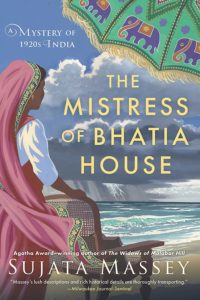 The Mistress of Bhatia House, Sujata Massey. Sujata Massey can do no wrong in my opinion, but this is one of the strongest and most thoughtful installments in her wonderful Perveen Mistry series. Perveen is the only female lawyer working in 1920’s Bombay. After a disastrous marriage, she lives pretty happily at home with her parents, working in the family firm. This novel has a theme of sisters, female connection and female agency. Perveen is struggling as her sister in law and former best friend, Gulnaz, returns home with her baby – it’s obvious she’s suffering from post partum depression and she’s pretty difficult and hostile. It also follows the two sisters in law at Bhatia House, where Perveen has attended a fundraiser in Gulnaz’s stead. Perveen gets caught up in the struggles of Suananda, the ayah of one of the boys at Bhatia House, who is fired after her charge is burned in an accident. What follows is a complex look at rape, lack of female agency in general, and a deft, shaded and intelligent look at the connections between women. Massey is truly top of the class and this thoughtful book could not be more timely.
The Mistress of Bhatia House, Sujata Massey. Sujata Massey can do no wrong in my opinion, but this is one of the strongest and most thoughtful installments in her wonderful Perveen Mistry series. Perveen is the only female lawyer working in 1920’s Bombay. After a disastrous marriage, she lives pretty happily at home with her parents, working in the family firm. This novel has a theme of sisters, female connection and female agency. Perveen is struggling as her sister in law and former best friend, Gulnaz, returns home with her baby – it’s obvious she’s suffering from post partum depression and she’s pretty difficult and hostile. It also follows the two sisters in law at Bhatia House, where Perveen has attended a fundraiser in Gulnaz’s stead. Perveen gets caught up in the struggles of Suananda, the ayah of one of the boys at Bhatia House, who is fired after her charge is burned in an accident. What follows is a complex look at rape, lack of female agency in general, and a deft, shaded and intelligent look at the connections between women. Massey is truly top of the class and this thoughtful book could not be more timely.
The Lady from Burma, Allison Montclair. This is a writer who goes from strength to strength. I truly love this series, and thought this book was a stand out. Iris and Gwen run the Right Sort marriage bureau in post war London. When they are approached by a woman who has waited through the war for her husband to return from Burma only to find she has cancer, but wants him to be “looked after” when she’s gone, the two spring into action, further spurred when the woman’s body is discovered in a forest. Gwen is also distracted as she waits for word from the “lunacy court” as to whether she will again be declared sane and can take full charge of her son. This is a thread running through all the books to date and brought to an excellent and suspenseful conclusion here. The tricky and intelligent mystery has a plot involving beetles, finances, and thwarted and uncertain romances for both Iris and Gwen. These books are pure, absolute delight.
Murder Under a Red Moon, Harini Negendra. Set in 1920’s Bangalore, this newish series is a standout. The extremely traditional, extremely intelligent stories follow new bride Kaveri Murthy as she adjusts to her new life and solves some crimes. In this outing her difficult mother in law begs her to look into an embezzlement situation at a family related business, but when Kaveri arrives, she discovers a body. Kaveri is ably helped in detection by her sweet, smitten husband, as well as by a police inspector who (unusually) welcomes her input and finds it invaluable. Negendra provides a layered and vivid look at Bangalore, really transporting the reader to a different time and place. She’s great with character and absolutely spectacular with plot. If you’re looking for a well done traditional mystery, look no farther than this wonderful series.
 A Disappearance in Fiji, Nilima Rao. What an amazing debut novel, set in a time and place I knew very little about. I love when I can learn something and don’t really notice I’m learning because the story is so wonderful. Set in 1914 Fiji, the struggling for workers sugar cane plantations imported indentured Indian workers. They could work for a period and then obtain freedom (they were basically slaves). When a disgraced police sergeant, Akal Singh, finds himself demoted from Hong Kong to Fiji he’s finding it tough going. Then a local priest insists the disappearance of a woman on one of the plantations be investigated, and Singh reluctantly heads to the plantation and finds himself transported with nostalgia, missing the smells and culture of his home in the Punjab. He also finds a heartbreaking story at the center of the disappearance, and with the help of a local doctor, completes his investigation. While the surroundings are grim, somehow, this book is not. It’s filled with lightness and joy for some magical writerly reason. Rao is obviously a natural born storyteller. Long may her career continue.
A Disappearance in Fiji, Nilima Rao. What an amazing debut novel, set in a time and place I knew very little about. I love when I can learn something and don’t really notice I’m learning because the story is so wonderful. Set in 1914 Fiji, the struggling for workers sugar cane plantations imported indentured Indian workers. They could work for a period and then obtain freedom (they were basically slaves). When a disgraced police sergeant, Akal Singh, finds himself demoted from Hong Kong to Fiji he’s finding it tough going. Then a local priest insists the disappearance of a woman on one of the plantations be investigated, and Singh reluctantly heads to the plantation and finds himself transported with nostalgia, missing the smells and culture of his home in the Punjab. He also finds a heartbreaking story at the center of the disappearance, and with the help of a local doctor, completes his investigation. While the surroundings are grim, somehow, this book is not. It’s filled with lightness and joy for some magical writerly reason. Rao is obviously a natural born storyteller. Long may her career continue.
 Two Wars and a Wedding, Lauren Willig. This isn’t really a mystery, but who cares. Lauren Willig is such a wonderful writer, any reader of historical fiction will find her books worthy reads. Set in 1896, she follows her fictional, frustrated archeology student Betsy Hayes as she’s refused a spot on digs because she’s a woman. Turning her frustration outward, Betsy decides to try her hand at war nursing, though she’s utterly inexperienced, and finds herself in the midst of the grim, short lived Greco-Turkish war of 1897. She then heads to Cuba and finds herself in the midst of the Spanish-American war, at times tending to some of the Yale boys she’d known in college. This was the time of Teddy Roosevelt’s Rough Riders, but Willig is no fan of war and doesn’t hesitate to paint a clear picture of the pain and death involved. Through all of this, Betsy remains intrepid and brave and learns on the job, becoming quite an accomplished nurse. She’s based on a real nurse who was able to get a shipload of boys back to the states after the war almost single handed. Willig plays with timelines, expectations, and adds a dash of romance to make her fictional creation sing. If you aren’t cheering for Betsy at the end of the novel, something is wrong with your heart.
Two Wars and a Wedding, Lauren Willig. This isn’t really a mystery, but who cares. Lauren Willig is such a wonderful writer, any reader of historical fiction will find her books worthy reads. Set in 1896, she follows her fictional, frustrated archeology student Betsy Hayes as she’s refused a spot on digs because she’s a woman. Turning her frustration outward, Betsy decides to try her hand at war nursing, though she’s utterly inexperienced, and finds herself in the midst of the grim, short lived Greco-Turkish war of 1897. She then heads to Cuba and finds herself in the midst of the Spanish-American war, at times tending to some of the Yale boys she’d known in college. This was the time of Teddy Roosevelt’s Rough Riders, but Willig is no fan of war and doesn’t hesitate to paint a clear picture of the pain and death involved. Through all of this, Betsy remains intrepid and brave and learns on the job, becoming quite an accomplished nurse. She’s based on a real nurse who was able to get a shipload of boys back to the states after the war almost single handed. Willig plays with timelines, expectations, and adds a dash of romance to make her fictional creation sing. If you aren’t cheering for Betsy at the end of the novel, something is wrong with your heart.
The White Lady, Jacqueline Winspear. I haven’t read a Maisie Dobbs book in quite awhile and was quite interested to see what Winspear could do with a standalone. Quite a lot, it turns out. Setting herself apart from a giant slew of WWII novels, this book follows the story of Elinor White, whose father disappears at the start of WWI. She, her mother and sister finds themselves on their own in their little Belgian town, and it’s not long before the girls are recruited by the resistance. The way the girls were recruited was not something I’d read about. It hardens Elinor into a capable resistance actor, and she finds herself back in action when WWII comes along. Epic is scale, the book is made intimate by Winspear’s careful character delineation of Elinor. Beautifully written and thoughtfully plotted, this is a read not to be missed. Read my interview with Jacqueline Winspear here.
Also notable: Killingly, Katharine Beutner’s melancholy look at a tragedy at a 19th century women’s college; Night Flight to Paris, Cara Black’s thrilling follow up to Three Hours in Paris; The Paris Assignment, Rhys Bowen’s emotional and compelling look at a reluctant WWII espionage agent; Evergreen, Naomi Hirahara’s follow up to Clark and Divison, as the Ito family adjusts to the life they’d left behind before interment camp; The Last Russian Doll, Kristen Loesch’s epic tale set during the Russian Revolution; The Big Sugar, Mary Logue’s brisk story of a woman on the American frontier; The Spanish Diplomat’s Secret, Nev March’s complicated and intelligent story set aboard ship; Playing it Safe, Ashley Weaver’s tale following WWII safecracker for the nation, Electra McDonnell.


